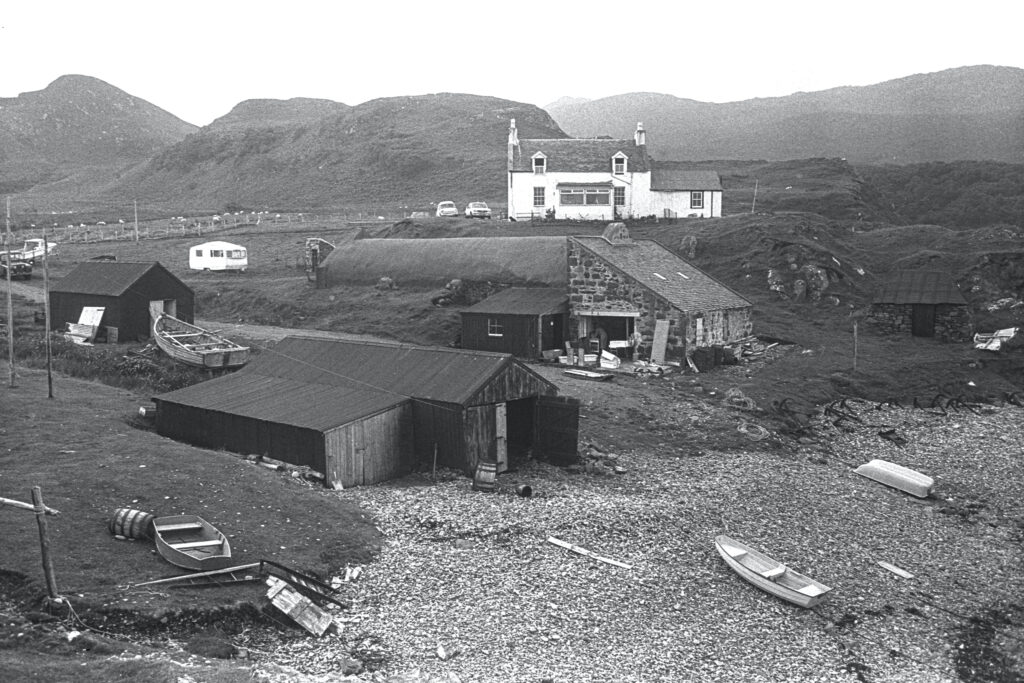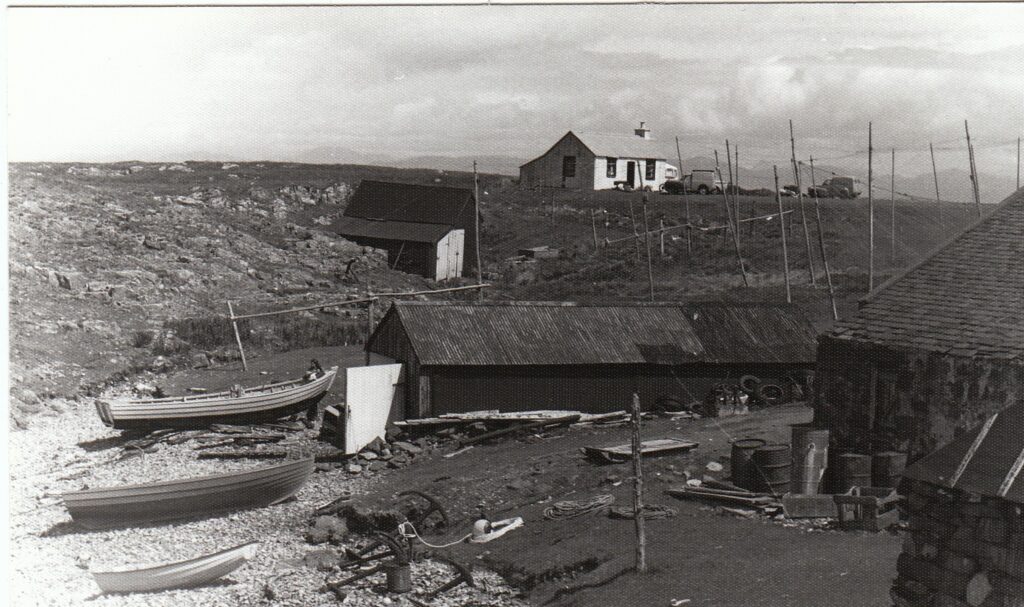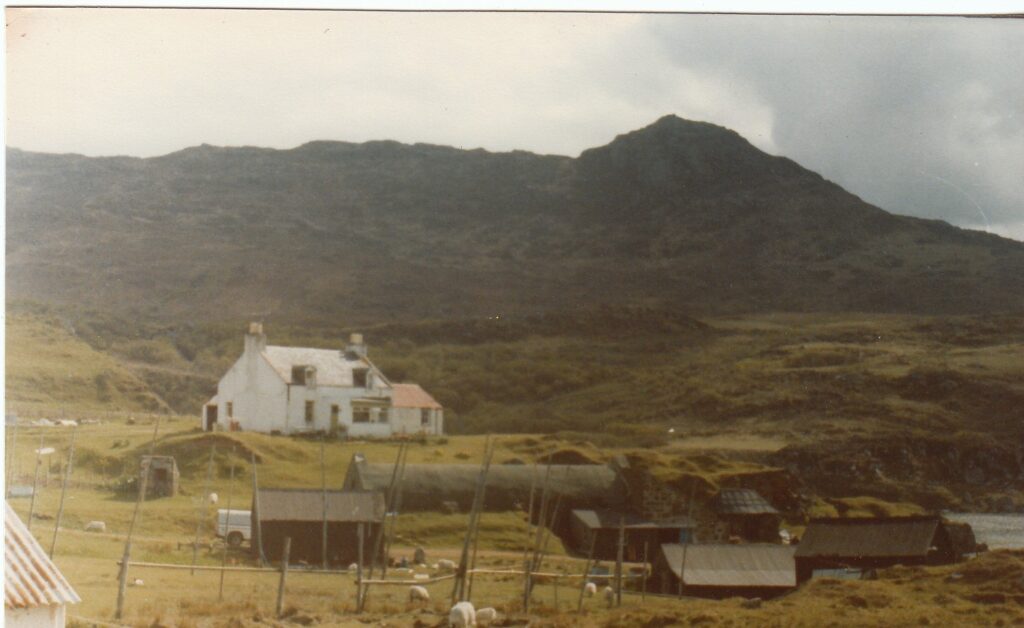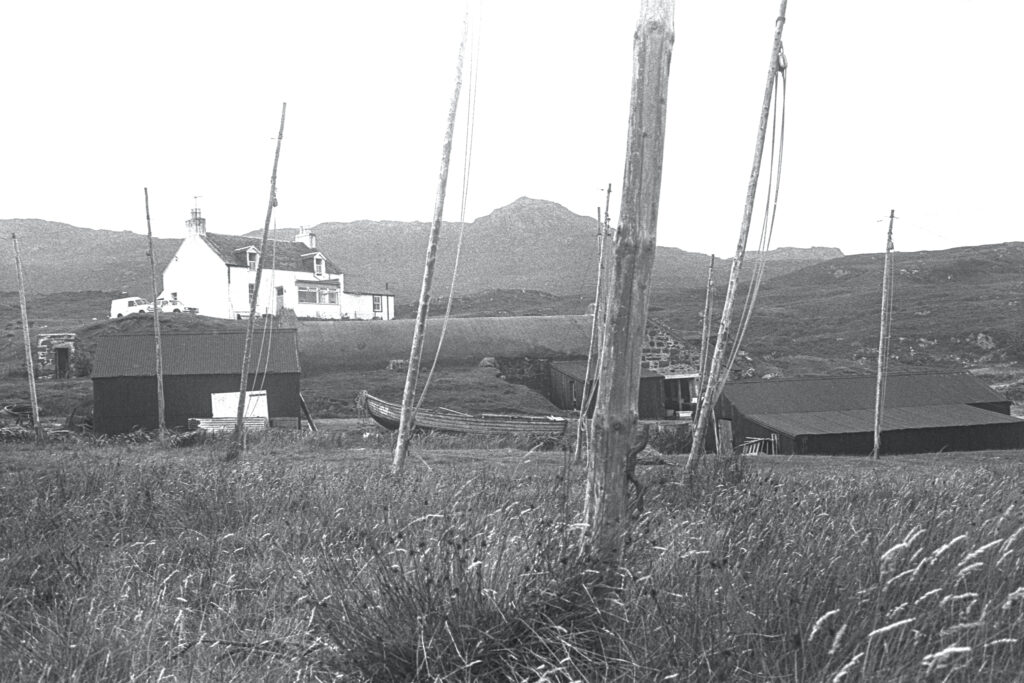Fascadale

© Don McAllester
Photo 100
Fascadale, summer 1975.
A view looking south across Fascadale from the headland.
In the fore ground is the stony “raised beach” up and down which each day dinghies had to be dragged, clean and dirty nets shifted and the catch carried.
The buildings in the background are, from right to left, the stone built stable: in days gone by, or so it was said, a pony would be kept there to transport ice frozen on the hill lochs through the winter down to the ice house for summer use In 1975 the stable was roofed, in fairly good structural condition but unused.
To the left is the “packing shed” which currently houses the salmon boat, 0B 209. Freshly landed fish were rinsed in fresh water, weighed and then placed, ungutted and belly up in wet newspaper lined wooden fish boxes before being covered with ice and the lid nailed down. The “packing shed” has a couple of fireplaces in its walls so is likely to have been used as domestic accommodation at some earlier time.
To the left of the packing shed is the small black lean to “engine shed”. Fascadale had no mains electricity in 1975 so had its own 4.8 KW water cooled Lister generator. Also in the engine shed was the ice making machine. This was a petrol engine driving compressed refrigeration gas around a heat exchanger in a big brine tank. The ice formed in open topped metal vessels that sat in the tank. The petrol engine was hand cranked and a block and tackle was needed to get the ice containers out of the tank. The big blocks of ice were then lifted into a hand cranked “mangle worzle” to be broken up.
Behind the engine shed and to the left of the packing shed is the “ice house” In 1975 this was used for general storage of very seldom used kit.
In earlier times the ice house had been used to store ice collected in the winter for use in the summer. Sunk into the ground and heavily built of stone, even on the hottest of summer days it was always cool inside this building. It was said that Fascadale had collected ice from three sources: hill lochs frozen through the winter when the pony kept in the stable would carry down the freshly cut ice in creels (baskets), the “ice pans” at Fascadale, still visible to the north of the gate and most interestingly it was said that vessels loaded with ice would an anchor in the bay and unload into the ice house.
In 1975 there was no mains electricity at Fascadale but by using the petrol driven compressor and brine tank ice could now be made on the site and so the ice house became a store. In 1977 mains electricity finally reached Fascadale and an electric ice making machine was purchased. Progress.
Above the ice house is “the house”, in 1975 home of Mr and Mrs Macleod. The right-hand end of the house had a corrugated iron extension, referred to as the “laundry”. This structure was in poor condition and never used. The house itself, was a basic two up two down, had an oil-fired Raeburn in the kitchen, a small “sitooterie” extension on the front and a small corrugated iron extension for a bathroom to the rear. There was also a corrugated iron lean to garage at the back.
At the left hand end of the icehouse it is just possible to make out a very small building referred to as the “smoker” but which had almost certainly been an outdoor privy. This structure had no door and little roof left.
The caravan, a tourer, was used from time to time to accommodate seasonal crew.
In the extreme left of the photo, and just visible is an old LandRover, used for towing boats up the beach. Photo xxx “Start of the Day”
Below and to the left of the caravan is a black corrugated iron shed, the workshop. This was a treasure house of old tools, bits of engine and nautical paraphernalia. This was a pre-electric workshop, hand tools, no power tools.
To the right of the workshop and below the icehouse are the two boat sheds. The larger of the two, with its doors open was the winter store for the “Wee” (18ft) coble and most of the other small boats that can be seen on the shore. Much of the ancillary gear required to fish the nets, the ropes, the chains, the poles and the cross sticks were in there through the winter.
The smaller lean to shed was where OB 209, a 26ft coble, the boat on display in the packing shed was laid up .
Visible between the boat shed and the workshop is another 26ft coble. By 1975 this boat had been so neglected that her timbers were rotten. She was burnt a couple of years later.
Also on the site, but not visible in this photo were the “tarry” shed, the net shed and the bothy. The tarry shed was the store for the chains and wire cables required to hold the nets in place at sea. This equipment was dipped in hot tar every year to prevent rust. Traditionally the tarring was the final and dirtiest job of the season. A big metal cauldron filled with tar thinned with diesel was heated then the chains and cables passed through it. One member of the crew, wearing seaboots, a knee length frock oilskin and gauntlets would then pull the chains and cables, now dripping with hot tar, into the shed and hang them from the rails there. At the end of the day the now completely tar covered seaboots and oilskin would be cut off that crew member . Beer would then be drunk
The bothy was home to up to four seasonal crew. This was a corrugated iron structure, concrete floor, two rooms and a small bathroom. Fairly primitive, it could just accommodate the four crew. If the wind came from the south the rain would blow under the door (see photo 777) and the floor would be a big puddle. Despite this most of those who lived in the bothy have fond memories of it.

No 101
Fascadale 1977
This photo was taken from the top of the small promontory beside the house looking NE towards the bothy.
This is an image from early in the season. There is an anchor at the top of the beach made up with its buoy ready to be laid. To the right of the anchor buoy is the big wooden sledge used for dragging nets from the boat and up the beach (link no WWW)
There are three boats at the top of the beach The nearest was a Norwegian built fibreglass Rana pram dinghy known as the “Banana”. This boat was very very seldom used. The middle of the three was again a Norwegian built larch 16 foot Rana. Again seldom used but well maintained. She was painted on the outside every year and treated with a 50:50 mix of linseed oil and turps on the inside. The third and biggest of the boats is the “Wee” coble used in the 1975 season. This boat has been painted and tarred ready to go to Ardtoe to fish the Gorteorn station. Sadly the boat ended her days derelict on the beach at Ardtoe. The end of a lovely little boat.
Beside the boat is the big boat shed with its doors built in the 1976 season. The corrugated iron roof was painted with bitumen from time to time in an effort so slow the rusting. This shed was pulled down and replaced in 1978 with a bigger steel and corrugated asbestos structure. That shed was dismantled when the Ardnamurchan Estate purchased Fascadale. It was re-erected at the east end of Loch Mudle where it stands today. Behind and to the right of the boat shed is the net green with its “dock poles” There is a bagnet hanging between the poles. To the left of this is the tarry shed and the net shed
At the top of the photo is the bothy, home for the seasonal workers. In 1977 most of the seasonal workers were recruited from Stirling University. The two vehicles visible were ex GPO yellow Morris 1000 vans, one belonging to a crew member the other to a visiting girlfriend.

Photo copyright Ben Dawson
An interesting view of the bothy from behind. Interestingly the roof was a different colour at the back from the front. The bothy had twp “lean-tos” at the back, the one on the left was the bathroom, the one to the right a coal shed.

Photo 801
Fascadale 1977
This photo was taken from just behind the bothy
It shows the net green with “dock poles” and all the sheds. It is possible to make out the “sitooterie” extension at the front of the house, the corrugated iron lean to garage at the rear and the corrugated iron (abandoned) “laundry at the far gable end.
The old derelict Salmon Coble visible in Photo 100 and Photo 802 has been burnt by this time . The green LandRover pickup just visible at the far left of Photo 100 has also been replaced by the silver one, the back of which is just visible behind the workshop and below the house
Fascadale had an interesting relationship with the local sheep. The property was fenced to keep most of them out but there were a small number that knew they could get round the seaward end of the fence at low tide. They were quite appreciated as they kept the grass on the net green nice and short.

© Don McAllester
Photo 802
Fascadale, 1975.
A view across the net green, from near the bothy towards the house. This photo shows the “dock poles” on the green. These poles were used to hoist the nets for inspection, repair and cleaning.
In the background, from left to right are the boatshed, the ice house, the house and the workshop, with the “smoker” just visible to the left.

© Don McAllester
Photo 803
Fascadale 1975
The tide is out: the dinghy has been left at the bottom of the beach and all the rocks are showing

Photo 804
Fascadale 1990s
The new boat shed, now long gone. This is the shed that was dismantled when the Estate cleared the site. The shed was re-erected at the end of Loch Mudle where it still stands
